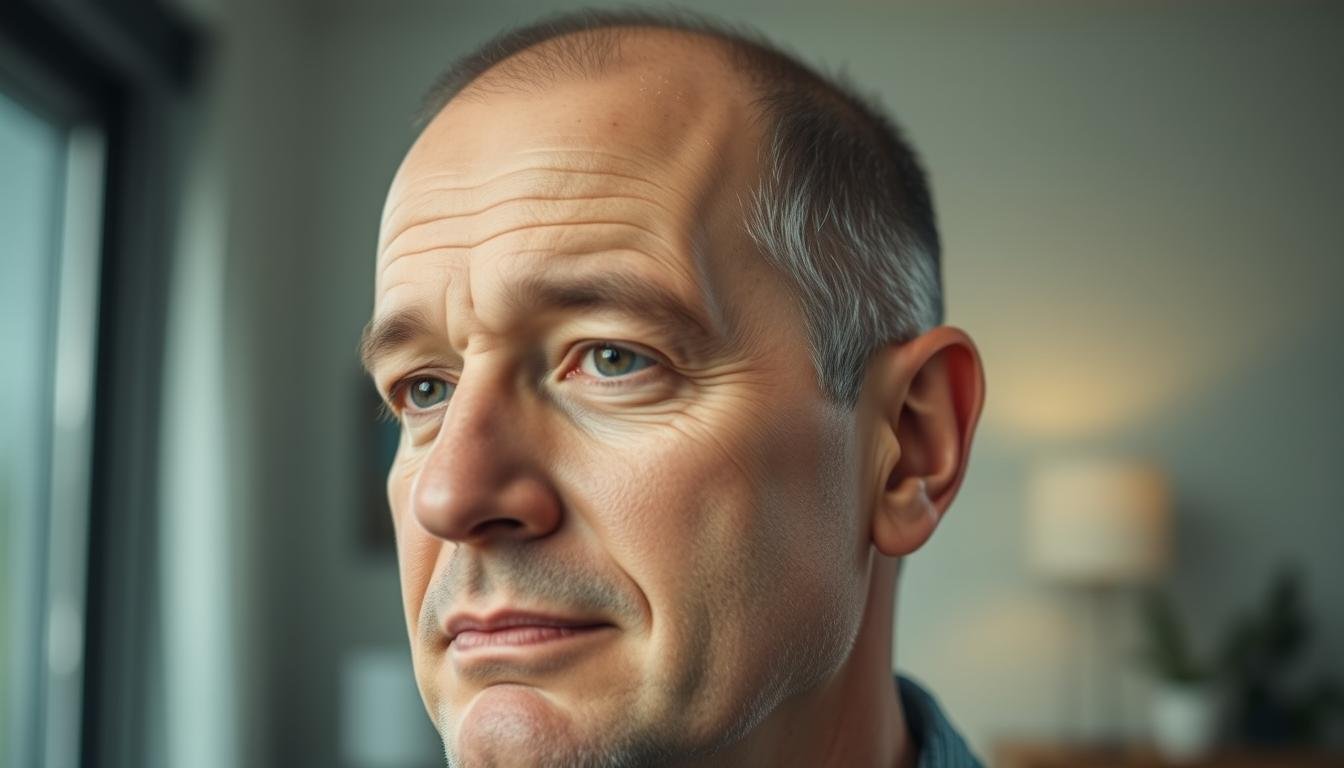Common Hair Problems in Men – Complete Guide 2024
Did you know that more than half of men aged over 50 in the UK experience Hair Loss? This widespread issue can significantly impact self-esteem and confidence. In this comprehensive Guide, we’ll explore the common hair problems that men face, including male pattern baldness, thinning, and receding hairlines. We’ll delve into the causes, solutions, and preventive measures to help you maintain healthy, vibrant hair and address hair loss effectively.
Key Takeaways
- Hair loss affects up to 50% of men by age 50, making it a widespread concern.
- Common signs of hair loss in men include receding hairline, temple and crown hair loss, and bald spots or patches.
- Causes of hair loss range from genetics and medical conditions to hairstyling methods, hormonal changes, and stress.
- A variety of treatments, from medications to hair transplants, are available to combat hair loss and promote regrowth.
- Adopting a healthy lifestyle, managing stress, and seeking professional help are crucial for maintaining healthy hair.
Understanding Hair Growth in Men
The average human head has about 100,000 hair follicles, each responsible for the growth and regeneration of individual strands. The hair growth cycle in men is a complex process influenced by various factors, including genetics, hormones, and environmental conditions.
The Hair Growth Cycle
Hair growth occurs in distinct phases, known as the anagen, catagen, and telogen phases. The anagen phase is the active growth stage, where hair follicles produce new hair strands. The catagen phase is a transitional stage, and the telogen phase is the resting stage, where hair follicles temporarily stop growing before shedding the old hair.
The length of each phase can vary from person to person, and disruptions in this cycle can lead to various hair-related issues, such as thinning, shedding, and even baldness.
Factors Influencing Hair Health
One of the primary factors influencing male hair health is the presence of dihydrotestosterone (DHT), a potent form of the male hormone testosterone. DHT can bind to hair follicles, causing them to shrink and eventually cease functioning, leading to hair follicles miniaturization and male pattern baldness.
Other factors that can affect hair growth and health include:
- Genetics: Hereditary factors play a significant role in determining an individual’s susceptibility to hair loss and the pattern of baldness.
- Testosterone levels: Fluctuations in testosterone levels can impact hair follicle function and contribute to hair thinning or shedding.
- Stress: High levels of stress can disrupt the hair growth cycle, leading to increased shedding and thinning.
- Nutritional deficiencies: Lack of essential vitamins, minerals, and proteins can impair hair growth and contribute to hair-related problems.
- Medications: Certain prescription drugs, such as those used for cancer treatment or thyroid disorders, can have adverse effects on hair health.
Understanding these factors is crucial for addressing hair problems effectively and maintaining healthy, vibrant hair.
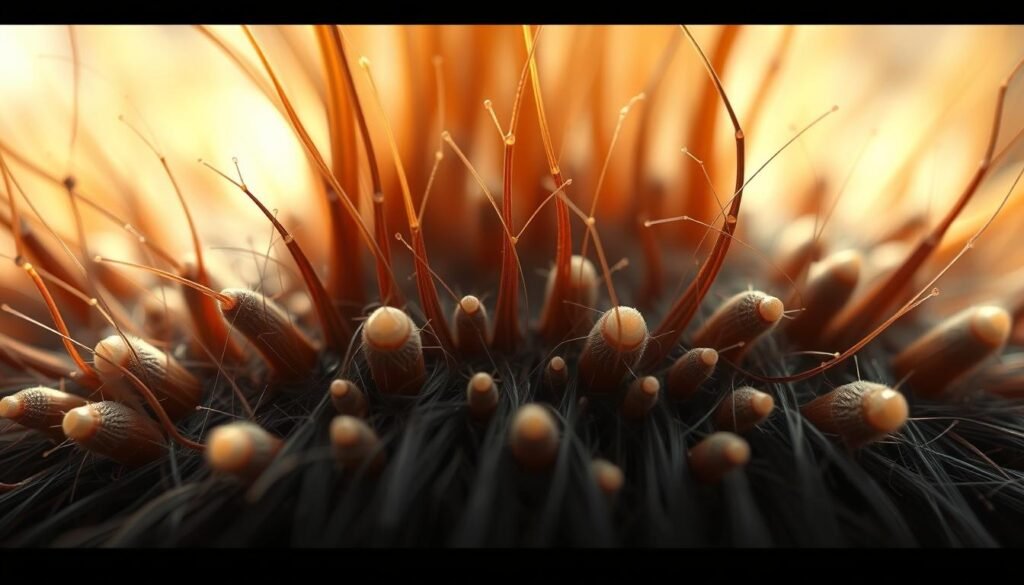
Hair Loss: Causes and Solutions
Hair loss is a common concern among men, and understanding the underlying causes is crucial for finding effective solutions. One of the most prevalent forms of hair loss is androgenetic alopecia, also known as male pattern baldness. This hereditary condition often begins with a receding hairline or thinning at the crown, eventually leading to a more pronounced bald spot on the top of the head.
Another type of hair loss, alopecia areata, results in patchy hair loss, while telogen effluvium causes general thinning across the scalp. These conditions can be triggered by various factors, including hormonal changes, medications, stress, and even certain hairstyles that put tension on the hair.
Androgenetic Alopecia
Male pattern baldness is primarily caused by genetic factors and the influence of the hormone dihydrotestosterone (DHT). This hormone can shrink hair follicles, leading to weaker, thinner hair and ultimately, hair loss. While there is no permanent cure for male pattern baldness, treatments like minoxidil and finasteride can help slow down the process and even promote new hair growth in some cases.
Alopecia Areata
Alopecia areata is an autoimmune disorder that causes patches of hair loss on the scalp and other areas of the body. The exact cause is not fully understood, but it is believed to be related to the immune system’s attack on healthy hair follicles. In some cases, this condition can lead to complete hair loss (alopecia totalis) or even loss of all body hair (alopecia universalis).
Telogen Effluvium
Telogen effluvium is a type of temporary hair loss that can occur due to various triggers, such as significant stress, illness, hormonal changes, or certain medications. During this process, a larger than normal number of hair follicles enter the resting (telogen) phase, leading to increased shedding. While concerning, telogen effluvium is often reversible once the underlying cause is addressed.
To address hair loss, a combination of treatments may be necessary, including medications, hair transplants, and lifestyle modifications. It’s important to consult with a dermatologist or hair specialist to determine the best course of action based on the individual’s unique situation and needs.
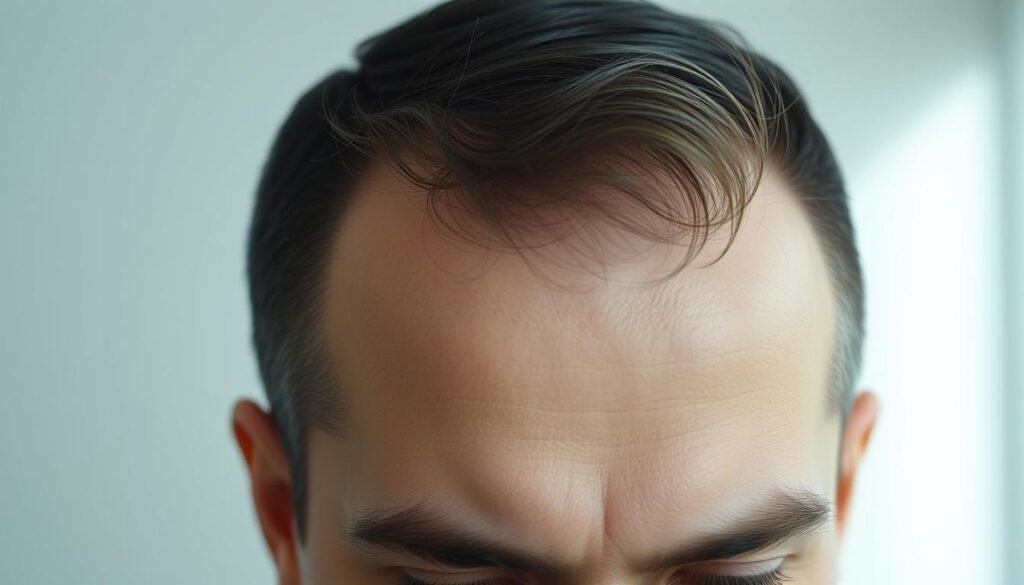
Dandruff Issues: An Overview
Dandruff is a common scalp condition that affects many individuals, often characterized by the unsightly presence of flaky, white or yellowish scales on the scalp. This frustrating problem can not only be visually unappealing but also cause irritation and itchiness for those who suffer from it. Understanding the root causes and available treatment options is key to effectively managing dandruff and maintaining a healthy, flake-free scalp.
Common Causes of Dandruff
The primary causes of dandruff include dry skin, a fungal infection known as Malassezia, and a skin condition called seborrheic dermatitis. Factors that can increase the risk of developing dandruff include age, with it being more common from the teenage years through midlife, as well as stress, certain medical conditions, and the use of harsh hair products. Newborns and young infants may also experience a type of dandruff called cradle cap.
Treatment Options for Dandruff
- Anti-dandruff shampoos containing active ingredients like ketoconazole, zinc pyrithione, or selenium sulfide can help control and alleviate dandruff symptoms.
- Maintaining good scalp hygiene through regular gentle shampooing and brushing can also help reduce the buildup of flaky skin.
- In some cases, prescription-strength medicated shampoos or topical treatments may be necessary for more severe or persistent cases of dandruff.
- Dietary supplements containing zinc, B vitamins, or gamma linolenic acid may help address underlying deficiencies, but more research is needed to confirm their effectiveness.
While dandruff is a common and often manageable condition, it’s important to seek medical attention if the symptoms are severe, persistent, or accompanied by other concerning signs, such as scalp irritation or infection. A dermatologist can provide personalized guidance and treatment options to help restore a healthy, flake-free scalp.
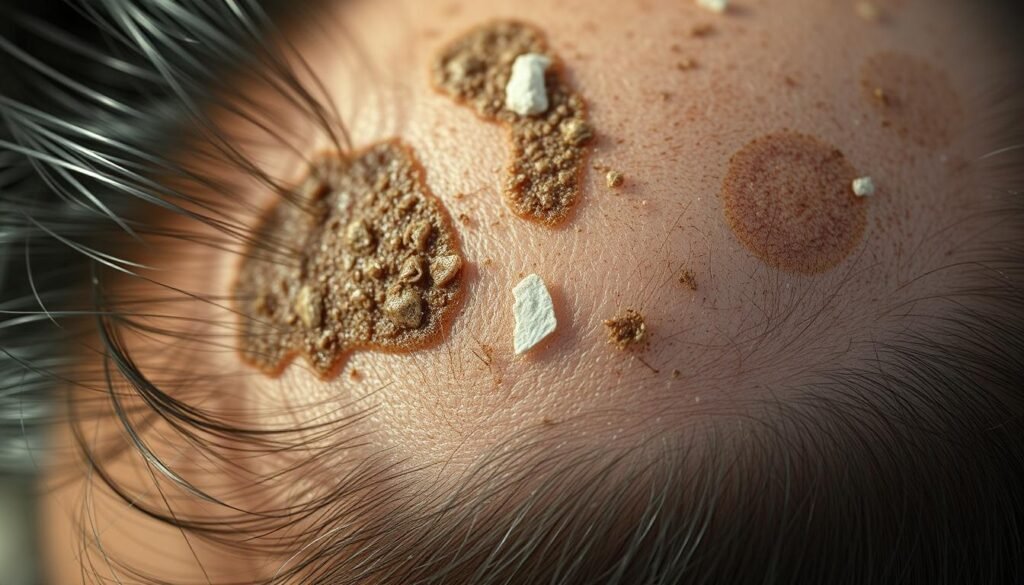
“Dandruff can be a frustrating and embarrassing problem, but with the right treatment approach, it can be effectively managed and controlled.”
Oily Hair: Causes and Management
Struggling with greasy or sebum-heavy hair can be a common challenge for many men. Oily hair results from an overactive sebaceous gland production, leading to an excessive build-up of sebum on the scalp and strands. Understanding the underlying causes and adopting the right management strategies can help restore a healthier hair and scalp balance.
Reasons for Excess Oil Production
Several factors can contribute to an oily scalp and hair. Hormonal changes, particularly during adolescence and adulthood, can stimulate the sebaceous glands to produce more sebum. Genetics also play a role, with some individuals inherently having more active oil glands. Environmental factors, such as humidity and stress, can further exacerbate oil production.
Certain skin conditions, like seborrheic dermatitis, eczema, and psoriasis, can also lead to an oily scalp by causing inflammation and irritation. This can disrupt the scalp’s natural balance and trigger increased sebum secretion.
Tips to Control Oily Hair
- Use a gentle, clarifying shampoo formulated for oily hair to help remove excess sebum and impurities from the scalp and strands.
- Avoid over-washing, which can actually stimulate the sebaceous glands to produce more oil as a compensatory response.
- Incorporate dry shampoo into your Routine, especially on days when you don’t want to fully shampoo, to absorb excess oil and refresh your appearance.
- Maintain a healthy diet rich in omega-3 fatty acids, which can help regulate oil production.
- Practice stress management techniques, as high-stress levels can contribute to increased sebum secretion.
- Consider using a leave-in treatment or serum containing ingredients like tea tree oil or apple cider vinegar, which may help control oil and balance the scalp’s pH.
If oily hair issues persist or worsen, it’s advisable to consult a dermatologist. They can help identify any underlying skin conditions and recommend more targeted treatments to effectively manage your oily hair concerns.
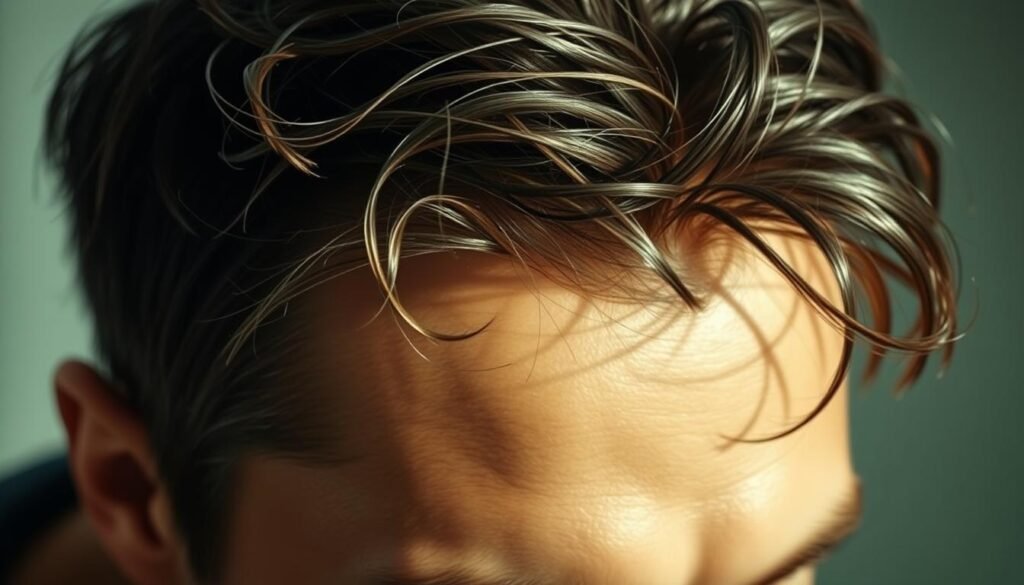
Dry and Damaged Hair: Prevention Strategies
Maintaining healthy, vibrant hair is a common challenge for many men. Dry and damaged hair can result from a variety of factors, including excessive heat styling, chemical treatments, and environmental stressors. Fortunately, with the right prevention strategies, you can safeguard your hair and keep it looking its best.
Identifying the Causes of Dry Hair
Men with curly or coily hair are particularly prone to dry hair due to the natural oils in their scalp not effectively reaching the ends of their hair. Additionally, thyroid imbalances, chlorinated water exposure, and the use of harsh hair products can all contribute to dry, brittle hair.
Best Practices for Healthy Hair
- Limit Heat Styling: Excessive heat from blow-drying, straightening, and curling can cause significant damage to hair. Use lower heat settings and apply a heat protectant product before styling.
- Nourish from Within: Maintaining a balanced diet rich in protein, vitamins, and minerals can support healthy hair growth and prevent damage. Stay hydrated and consider taking a hair-strengthening supplement if necessary.
- Gentle Hair Care: Choose sulfate-free, moisturizing shampoos and conditioners, and avoid over-washing your hair. Incorporate deep conditioning treatments into your Routine to replenish lost moisture.
- Trim Regularly: Getting regular trims can help prevent split ends and keep your hair looking its best. Aim for a trim every 6-8 weeks, or as needed.
By addressing the root causes of dry, damaged hair and adopting a proactive Hair Care regimen, you can achieve stronger, more vibrant locks that are resistant to breakage and split ends.
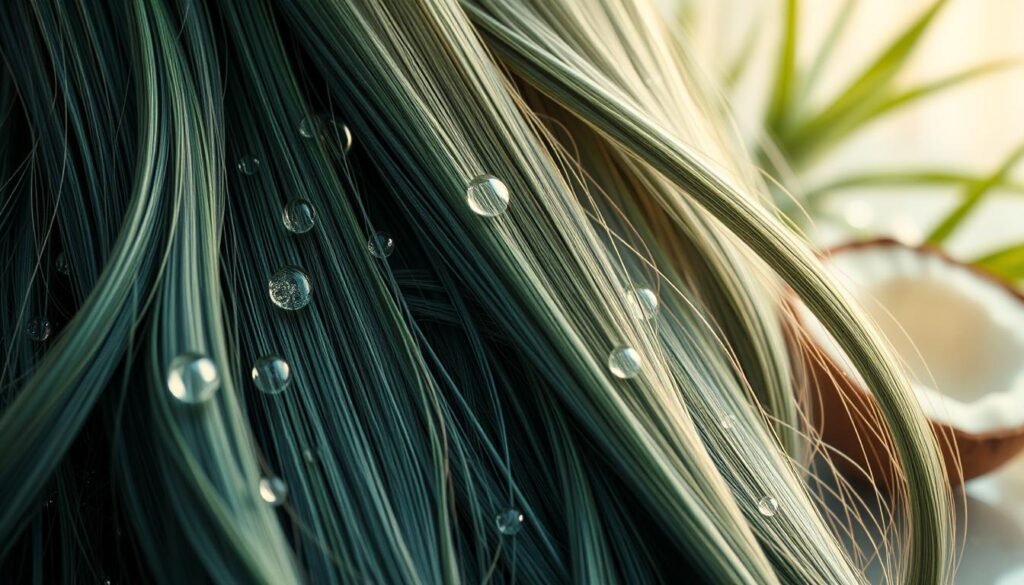
“Healthy hair starts from the inside out. Nourish your body and your hair will follow.”
| Hair Type | Common Hair Damage | Best Prevention Strategies |
|---|---|---|
| Straight/Wavy | Breakage, split ends | Limit heat styling, use gentle products, deep condition regularly |
| Curly/Coily | Dryness, frizz, loss of volume | Hydrate hair with oils and masks, avoid over-washing, protect from humidity |
| Fine/Thin | Thinning, breakage | Use lightweight products, avoid heavy oils, maintain a healthy scalp |
Thinning Hair: Signs and Remedies
Experiencing thinning hair can be concerning for many men, but understanding the early signs and exploring effective treatments can help restore a fuller, healthier head of hair. Whether it’s due to genetics, lifestyle factors, or underlying medical conditions, addressing thinning hair can be a crucial step in maintaining your confidence and appearance.
Early Signs of Thinning Hair
Recognizing the early signs of thinning hair is crucial for taking proactive measures. Some common indicators include:
- Increased hair shedding, with more than the normal 50-100 hairs lost per day
- Visible scalp through the hair, especially at the part line or temples
- Changes in hair texture, becoming finer or more fragile
Effective Treatments for Thinning Hair
Thankfully, there are several treatments available to combat thinning hair and promote hair regrowth. Some of the most effective options include:
- Topical Minoxidil (Rogaine): An over-the-counter medication that can stimulate hair growth and slow down hair loss. It may take 16 weeks or more to see visible results.
- Oral Finasteride (Propecia): A prescription medication that blocks the conversion of testosterone to dihydrotestosterone, a key contributor to male pattern baldness.
- Scalp Micropigmentation: A cosmetic procedure that creates the illusion of fuller, thicker hair by strategically implanting pigment into the scalp.
- Hair Growth Serums: Containing vitamins, minerals, and other active ingredients, these serums can help improve hair density and quality.
- Scalp Massage: A gentle massage can improve blood flow to the scalp, potentially stimulating hair regrowth.
- Essential Oils: Oils like lavender, rosemary, and thyme have shown promise in promoting hair growth, although more research is needed.
Remember, the key to effectively addressing thinning hair is to address the underlying causes and explore a combination of treatments tailored to your individual needs. Consulting with a dermatologist can help you develop a personalized plan to regain your hair density and confidence.

| Thinning Hair Causes | Potential Regrowth Possibilities |
|---|---|
| Hereditary hair loss (male/female pattern baldness) | Regrowth may be possible with consistent use of FDA-approved treatments like minoxidil and finasteride |
| Age-related hair loss | Regrowth unlikely, but treatments can help slow down the thinning process |
| Alopecia areata (autoimmune condition) | Regrowth may occur with treatment, but the condition can recur |
| Chemotherapy or radiation treatment | Hair typically regrows within months of completing treatment |
| Stress-induced hair loss (telogen effluvium) | Hair regains fullness within 6-9 months after the stressful event |
| Damage from hair treatments or tight hairstyles | Regrowth may not be possible if the hair follicles are permanently damaged |
“Addressing thinning hair early and exploring a combination of treatments can make a significant difference in regaining a fuller, healthier head of hair.”
Scalp Conditions Affecting Men’s Hair
Maintaining a healthy scalp is crucial for men to achieve strong, vibrant hair. Unfortunately, various scalp conditions can disrupt this delicate balance, leading to issues like scalp inflammation, itchy scalp, and overall scalp health concerns. Let’s explore some of the common scalp conditions that can affect men’s hair.
Psoriasis
Psoriasis is a chronic autoimmune condition that can manifest on the scalp, causing red, scaly patches. This scalp inflammation can lead to itchiness, flaking, and in some cases, temporary hair loss. Proper management with medicated shampoos and topical treatments can help control the symptoms and maintain scalp health.
Folliculitis
Folliculitis is an inflammation of the hair follicles, often caused by bacterial, fungal, or parasitic infections. This condition can result in itchy scalp, small bumps, and potentially even permanent hair damage if left untreated. Addressing the underlying cause with appropriate medical intervention is crucial for restoring scalp health.
Seborrheic Dermatitis
Seborrheic dermatitis is a common condition that leads to redness, scaling, and flaking on the scalp. This scalp inflammation can create an unpleasant, itchy scalp experience. Medicated shampoos and topical treatments, along with maintaining good scalp hygiene, can help manage this condition and maintain overall scalp health.
If you are experiencing persistent scalp issues, it is advisable to consult a dermatologist. They can provide a proper diagnosis and recommend the most effective treatment options to address the underlying condition and restore your scalp health.
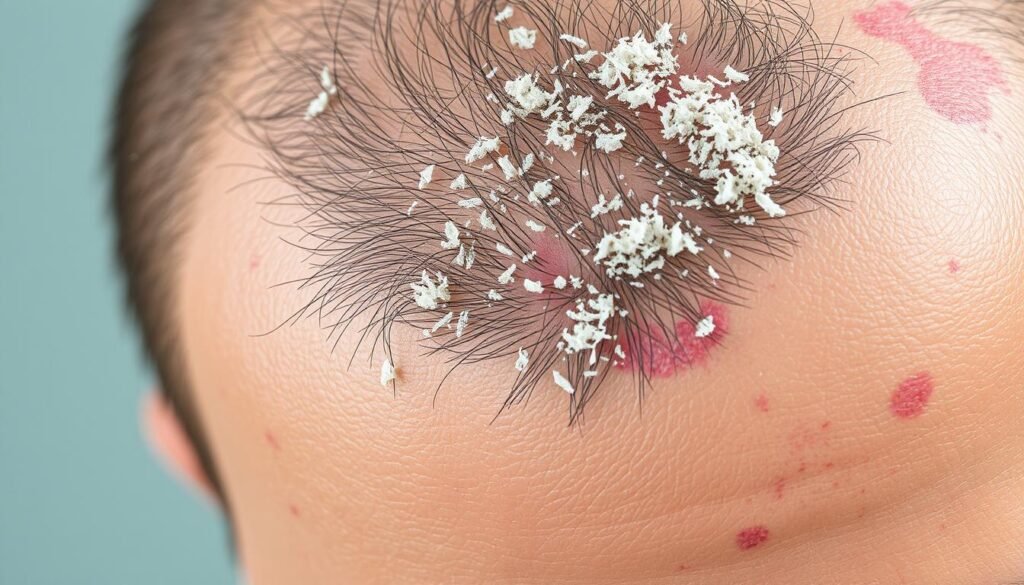
Hair Styling and Product Damage
Maintaining a healthy, vibrant head of hair can be challenging for many men, especially when it comes to the potential pitfalls of hair styling and product use. Excessive styling and the use of improper hair products can lead to significant damage, negatively impacting the overall appearance and condition of your locks.
Common Stylist Mistakes
One of the primary culprits of hair damage is the overuse of high-heat styling tools, such as blow dryers, curling irons, and straighteners. Exposing your hair to extreme temperatures can strip away its natural oils, leading to dryness, brittleness, and increased susceptibility to breakage. Additionally, over-processing with chemical treatments, like bleaching or coloring, can severely compromise the integrity of your hair.
Selecting Hair Products Wisely
The products you choose to use on your hair can also make a significant difference in its overall health and appearance. Avoiding shampoos and styling products that contain harsh ingredients, such as sulfates, parabens, and alcohol, is crucial. These harsh chemicals can strip your hair of its natural oils, leaving it dry, frizzy, and prone to damage. Instead, opt for sulfate-free, gentle formulas that are enriched with nourishing ingredients like aloe vera, argan oil, and shea butter. These natural alternatives can help to hydrate, strengthen, and protect your hair, minimizing the risk of long-term damage.
By being mindful of your styling techniques and the products you use, you can take proactive steps to maintain the health and vitality of your hair. Remember, a little extra care and attention can go a long way in preserving the hair styling, hair products, and hair damage you’ve worked so hard to achieve.
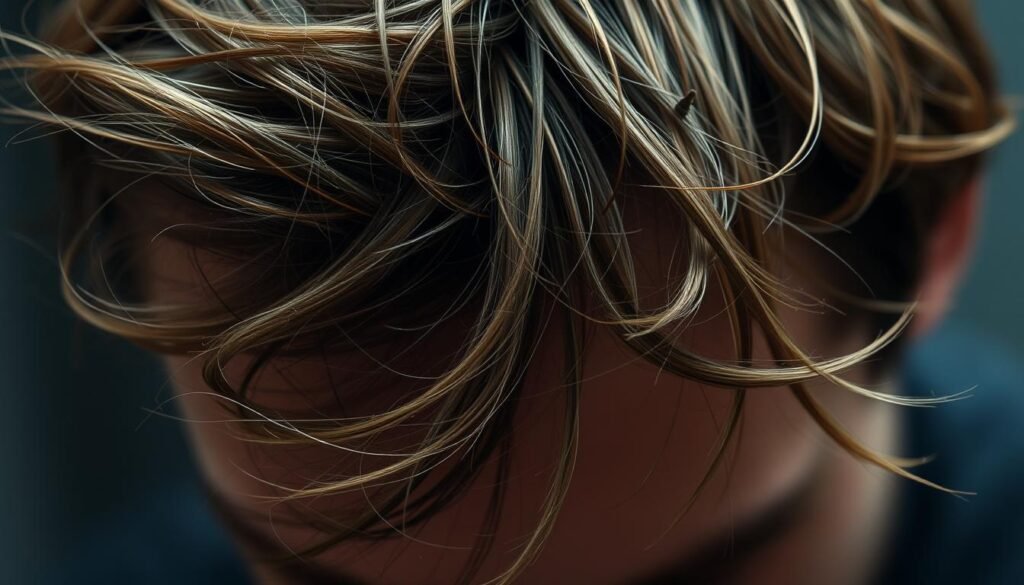
Hair Color Issues: Graying and Dullness
As we age, many men experience the inevitable – gray hair. While some embrace this natural progression, others may find it challenging to maintain vibrant, youthful-looking hair color. Understanding the factors that contribute to premature graying and learning how to keep hair looking its best can help men feel confident and stylish.
Factors Leading to Premature Graying
Premature gray hair can be caused by a variety of factors, including genetics, stress, and nutritional deficiencies. Studies show that the average person loses around 100 hairs per day, and the onset of graying in Caucasians is typically around 34 years old, with a standard deviation of 9.6 years. In contrast, African Americans may start seeing gray hairs in their mid-40s.
Certain lifestyle factors, such as smoking, can also contribute to early graying. Smokers are about 2.5 times more likely to experience premature graying before the age of 30 compared to non-smokers. Nutritional deficiencies in copper, iron, and vitamins have also been linked to the premature loss of hair pigmentation.
Maintaining Vibrant Hair Color
To keep hair looking its best, men can use hair dyes or color-depositing products to conceal gray strands. Color-safe shampoos and limiting sun exposure can also help preserve the natural hair pigmentation. A diet rich in antioxidants and vitamins can support the health of hair follicles and slow the graying process.
For those who prefer a more natural approach, henna-based treatments can provide a chemical-free way to add color and shine to gray hair. Consulting with a professional stylist can also help men transition to their natural gray hair gracefully, incorporating techniques like highlights to blend the gray strands.

“Graying is a natural part of the aging process, but with the right care and attention, men can keep their hair looking vibrant and youthful.”
Men’s Hair Care Routine
Maintaining a proper hair Care Routine is essential for men who want to keep their locks healthy and stylish. From regular washing to protecting hair from environmental damage, the right steps can make a significant difference in the appearance and overall condition of your mane.
Essential Steps for Hair Care
The foundation of a good Hair Care routine for men includes the following essential steps:
- Wash hair with a sulfate-free shampoo suited to your hair type, avoiding over-washing which can strip natural oils.
- Condition hair regularly to keep it moisturized and manageable, using a leave-in conditioner for added nourishment.
- Protect hair from sun, wind, and other environmental factors by wearing a hat or using a hair serum or oil.
- Avoid excessive heat styling, which can lead to dryness and damage over time.
- Regularly trim split ends to maintain a healthy, polished appearance.
Recommended Products for Men
To achieve the best results, consider incorporating the following hair care products into your routine:
- Sulfate-free Shampoo – Opt for a gentle, sulfate-free formula that cleanses without stripping away natural oils.
- Leave-in Conditioner – A leave-in conditioner can provide ongoing hydration and smoothness to your hair.
- Hair Oil or Serum – These products help to nourish, tame frizz, and protect hair from environmental damage.
- Styling Products – Choose a lightweight, water-based styling product to shape and hold your hairstyle without weighing down your locks.
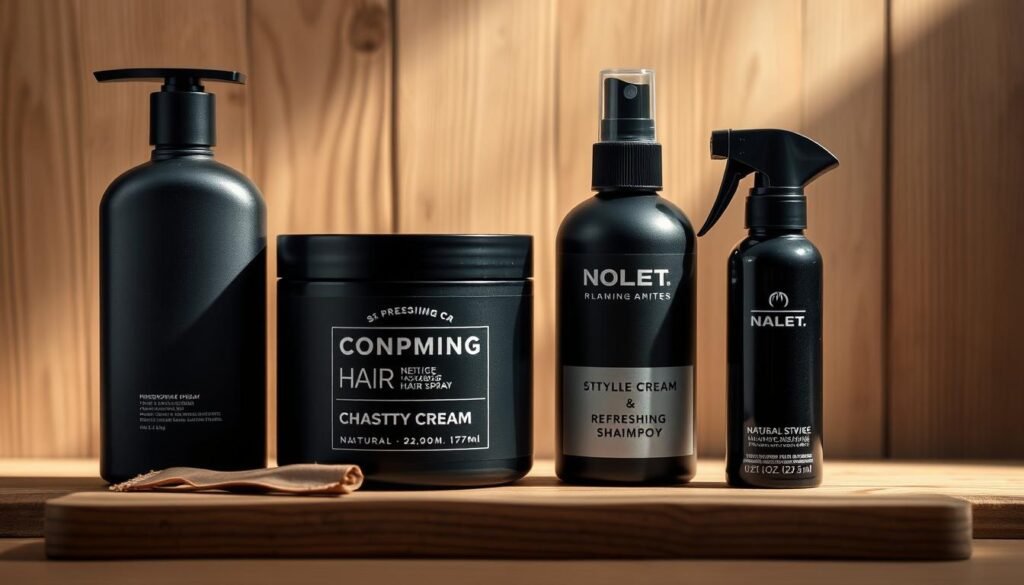
By following these essential steps and incorporating the right products, men can achieve a healthy, well-groomed appearance and maintain their hair’s vitality for years to come.
When to Seek Professional Help
While self-care and over-the-counter treatments can address many common hair problems, there are times when it’s crucial to seek the expertise of a dermatologist or hair specialist. If you’re experiencing sudden or unexplained hair loss, persistent scalp issues, or if your at-home remedies aren’t producing the desired results, it’s time to consult a professional.
Signs It’s Time to Consult a Dermatologist
Sudden and excessive shedding, patchy hair loss, severe dandruff, or an itchy, irritated scalp are all signs that you may need professional assistance. Dermatologists can accurately diagnose the underlying cause of your hair woes, whether it’s androgenetic alopecia, alopecia areata, or another condition, and develop a personalized treatment plan.
What to Expect During a Hair Consultation
During a hair consultation, the dermatologist will conduct a thorough examination of your scalp and hair. They may also gather information about your medical history, lifestyle, and any recent changes that could be contributing to your hair issues. In some cases, they may order additional tests, such as a scalp biopsy or blood work, to pinpoint the cause. Based on the findings, the dermatologist can then recommend the most appropriate treatment, which may include prescription medications, specialized therapies like platelet-rich plasma (PRP) injections, or even surgical options like hair transplants for advanced hair loss.
FAQ
What are the common hair problems faced by men?
Common hair problems in men include male pattern baldness, hair thinning, receding hairline, dandruff, oily hair, dry and damaged hair, and premature graying.
What is male pattern baldness and what causes it?
Male pattern baldness, also known as androgenetic alopecia, is the most common form of hair loss in men. It is caused by a sensitivity to the hormone dihydrotestosterone (DHT), a potent form of testosterone, which can lead to gradual hair follicle miniaturization and hair loss.
How can men address hair thinning and receding hairlines?
Effective treatments for thinning hair and receding hairlines include topical minoxidil, oral finasteride, and scalp micropigmentation. Hair growth serums containing vitamins and minerals can also help improve hair density and quality.
What are the common causes and treatments for dandruff?
Dandruff can be caused by dry skin, seborrheic dermatitis, or fungal infections. Treatment options include anti-dandruff shampoos containing ingredients like ketoconazole, zinc pyrithione, or selenium sulfide. Proper scalp hygiene and stress management can also help control dandruff.
What are the factors contributing to oily hair and how can it be managed?
Oily hair is often caused by overactive sebaceous glands producing excess sebum, which can be influenced by hormonal changes, genetics, and environmental factors. To manage oily hair, use gentle, clarifying shampoos, avoid overwashing, and consider using dry shampoo between washes. Proper diet and stress management can also help regulate oil production.
How can men prevent and treat dry and damaged hair?
To prevent damage, limit the use of heat tools, use heat protectants, and opt for gentle hair care products. Regular deep conditioning treatments and trims can help maintain hair health and prevent split ends.
What are the early signs of thinning hair and what can be done about it?
Early signs of thinning hair include increased shedding, visible scalp, and changes in hair texture. Effective treatments for thinning hair include topical minoxidil, oral finasteride, and scalp micropigmentation. Hair growth serums containing vitamins and minerals can also help improve hair density and quality.
What are some common scalp conditions that can affect men’s hair?
Common scalp conditions that can affect hair health include psoriasis, folliculitis, and seborrheic dermatitis. Treatment options may include medicated shampoos, topical steroids, and in some cases, oral medications prescribed by a dermatologist.
How can excessive styling and product use damage hair?
Excessive styling and improper product use can lead to hair damage. Common mistakes include using high heat settings on styling tools, over-processing with chemicals, and using products with harsh ingredients. To minimize damage, choose sulfate-free shampoos, use heat protectants, and opt for gentle styling methods.
What causes premature graying and how can it be managed?
Premature graying can be caused by genetics, stress, or nutritional deficiencies. To maintain vibrant hair color, use color-safe shampoos, limit sun exposure, and consider using hair dyes or color-depositing products. A diet rich in antioxidants and vitamins can also help maintain natural hair color.
What should a proper hair care Routine for men include?
A proper hair Care Routine for men includes regular washing with suitable shampoo, conditioning, and protecting hair from environmental damage. Essential steps include using the right products for your hair type, avoiding overwashing, and protecting hair while sleeping. Recommended products may include sulfate-free shampoos, leave-in conditioners, and hair oils for added nourishment.
When should men seek professional help for their hair problems?
Consult a dermatologist if you experience sudden hair loss, persistent scalp issues, or if over-the-counter treatments aren’t effective. During a hair consultation, expect a thorough examination of your scalp and hair, discussion of medical history, and possibly tests to determine the cause of hair problems. A dermatologist can provide personalized treatment plans and recommend advanced therapies when necessary.
